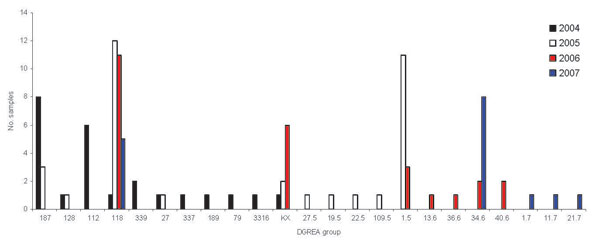Volume 15, Number 2—February 2009
Research
Epidemiology of Vibrio parahaemolyticus Outbreaks, Southern Chile
Figure 3

Figure 3. Number of seafood samples containing Vibrio parahaemolyticus corresponding to different direct genome restriction enzyme analysis (DGREA) groups observed in Puerto Montt, Chile, each summer, 2004–2007.
Page created: December 06, 2010
Page updated: December 06, 2010
Page reviewed: December 06, 2010
The conclusions, findings, and opinions expressed by authors contributing to this journal do not necessarily reflect the official position of the U.S. Department of Health and Human Services, the Public Health Service, the Centers for Disease Control and Prevention, or the authors' affiliated institutions. Use of trade names is for identification only and does not imply endorsement by any of the groups named above.